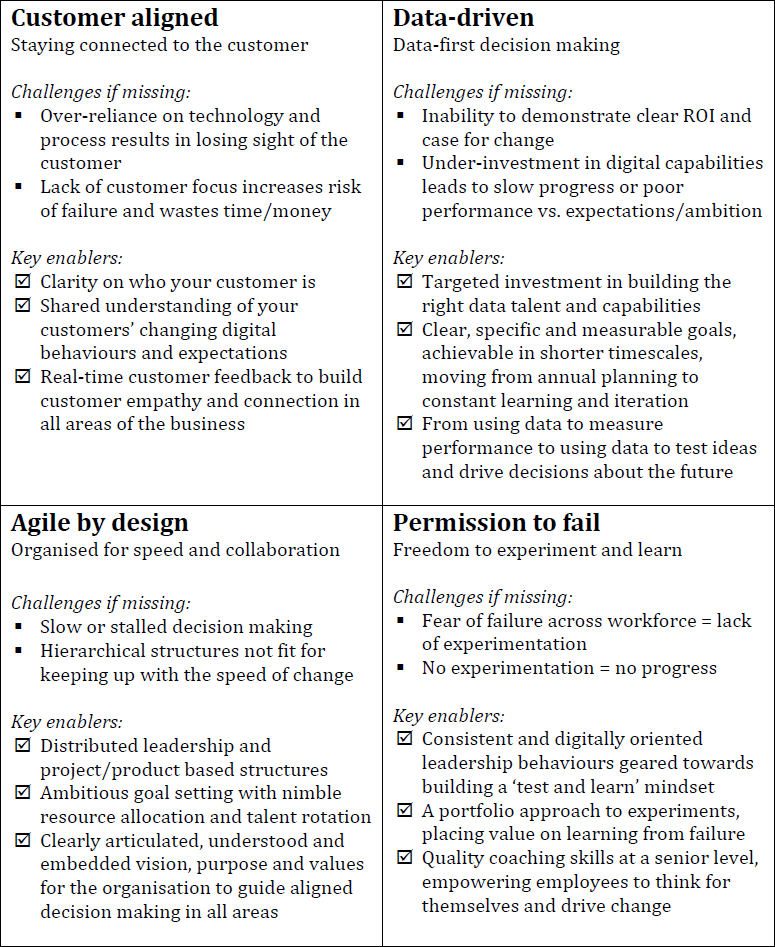It is rare to find an organisation these days without ambitions to digitally transform, as even the most traditional leaders are realising that they need to build multi-channel customer experiences in order to remain competitive. Article by Rich Webley, Managing Director – Dragonfish.
The reality, however, is that most companies struggle to achieve their digital goals, or in some cases, fail to get started at all. The change required often goes against established ways of working, and can be seen as a threat to management practices that have existed for decades as a company overhauls its capabilities in pursuit of digital excellence.
Inability to digitally evolve at a pace that keeps up with consumer behaviour is a risk to even the most well established businesses. One only has to look at Blockbuster’s 2010 bankruptcy, just three years after the launch of Netflix’s streaming‐video business, to see that in some sectors, digitisation is not simply a good thing – but a matter of survival. Holding on to an out of date business model for too long in a world of infinitely growing consumer choice, simply isn’t an option for executives who want to have confidence they’ll still be trading this time next year.
On a more positive note, the upside for brands of getting this right is huge. Whether through converting data from online sales to generate more sales, delivering seamless online service to improve customer retention, or introducing new digitally enabled business models to disrupt a mature market – it has become clear that fully embracing the digital era comes with a range of untapped opportunities for brands to unlock improved commercial performance. In 2006, Burberry was significantly underperforming. Angela Ahrendts took over driving a transformation programme focused on CX and digital technology. The business is now doing really well with an 18% jump in sales in the first quarter of this year – providing a useful reminder that often, transforming digitally puts an organisation in the best position to transform financially.
So the last decade has proven that digital transformation is a necessity for some, commercially appealing for others – but difficult for all. With this in mind, what do we think makes the transition easier for some companies than others?
In a word: Culture.
It is easy to assume that digital transformation is about technology and process – with senior management often placing over‐reliance on some of the more formal and structural levers of change to aid digitisation – however it is important to recognise that success comes from the people in a business adopting new ways of working. And it is the organisation’s patters of thinking, feeling and behaving that will impact its ability to innovate and adopt new technology.
Culture’s not just some mysterious, unseen presence. It can be shaped. And when that shaping is done properly, culture can be the positive force behind an organisation’s ability to change, learn, adapt and perform. Good instead of bad. Win instead of lose.
It is equally well evidenced that shortcomings in organisational culture are one of the main barriers to company success in the digital age, which was the central finding from McKinsey’s 2016 research with over 2000 global executives.
The notion that organisational culture can make or break any digital transformation plan is not new news. What’s missing, however, is clarity and practical guidance for organisations shaping their digital ambitions around how to prepare their culture for the journey ahead. This article provides exactly that. Our view, grounded in research, on the four attributes of a culture that is ready for digital transformation. We want companies to think of culture change as a force – the force – that will enable them to achieve their digital ambitions, and have the confidence and clarity to approach it with the same rigor and discipline with which they have been tackling operational transformations for years.
1. Customer alignment – staying true to the customer
An over-focus on technology and process can easily result in losing sight of the customer. So it is important to remember that the process of digital transformation is fundamentally about becoming or remaining customer‐led, through building your business around your customers’ (increasingly digital) lives. It isn’t an internal change project – it is about customers. What’s going on ‘out there’ is more important than how we get things done ‘in here’.
Often businesses can be jolted into a digital transformation programme for fear of being left behind by developments they observe in competitors, meaning they get started in the absence of a solid understanding of who their customer is and how their digital behaviours and expectations are changing. This makes it very difficult to prioritise well, gather momentum and leave a lasting impact. A false start. What’s more, the world of digital is advancing and diversifying at such a speed that chasing the competition or following the latest digital trend is the fastest way to waste time and money if you don’t have (and maintain) a relentless focus on the end customer.
It’s also useful to remember that a digital culture is customer‐centric by definition. It is about a focus on the customer experience irrespective of channel. Most companies just happen to be less mature in digital channels so this requires the greatest effort and targeted investment to keep up with customer expectations.
Our biggest tip to any organisation approaching a digital transformation programme would be to start by ensuring the level of customer alignment in the organisation is where it needs to be first. Or at the very least, invest in a sustained effort to help your teams to develop a deeper appreciation for and empathy with your customers while you transform. It is essential to remember that digital transformation is about getting everyone in the organisation to relate differently to its customers and their digital worlds. Every conversation about digital should focus on the customer and what they need from you. Every conversation about the customer should focus on the insight you have or the insight you need. It is the role of leaders to make these connections clear, strong and living in the organisation.
2. Data driven – enabling data‐first decision making
Digital transformation programmes can stall due to an unclear case for change and the ROI associated, making it too easy for leaders and teams to cling on to traditional sales channels or analogue ways of working. Inability to demonstrate clear ROI, results in under‐investment in digital talent and capabilities, which leads to slower progress, stretched resource and scarce headspace to measure the right things or demonstrate clear ROI. It’s a diminishing cycle that only ever results in the organisation failing to achieve its full digital ambitions.
A culture ready for digital transformation is commercially minded and data‐driven. Ideas are tested and decisions are made based on the resulting evidence. It is about moving from a traditional cycle of deciding upon the ‘big stuff’ during annual business planning, setting the plan and then spending the rest of the year delivering it – to building a learning organisation that is able to rapidly iterate based on what’s working and what’s not. This takes investment in the data capability and talent that in many businesses would have been considered a luxury five years ago. But is an investment worth making if you want your digital transformation efforts to make a lasting and sustainable difference.

The good news is that using data to get closer to your customers can help reduce the risk of experimentation and support faster‐paced change. Moving from quarterly focus groups to ‘always on’ user testing, real-time customer feedback and advanced predictive modeling of customer data removes the guesswork from launching new digital innovations and dramatically increases your chances of success first time. Thus creating a positive cycle of improved performance and cost savings that can start to pay back your investment in data capability and fuel future growth.
3. Agile by design – organise for speed and collaboration
Digital transformation efforts can often be hindered by slow or stalled decision‐making, fuelled by internal politics and attempts to make decisions by committee. Successful digital transformation depends on speed and the ability to navigate between strategy development, planning, testing and learning with ease and crucially, without too many meetings. Ultimately this comes down to organisational agility, which takes time to build and can’t be paid for or switched on like a new piece of technology.
Often the type of agility required here is at odds with traditional hierarchical structures and ways of making decisions in large organisations, according to Deloitte’s research in 2016, who found that organisations with high levels of digital maturity tend to think distributed leadership over hierarchical, taking steps to move from vertical to project/product based structures in order to move at pace and keep up with the speed of change in their industry.
While this kind of fast and flat decision‐making might feel uncomfortable to some leaders who have previously operated in more traditional models – the single most impactful way they can de‐risk distributed leadership is through creating and maintaining real clarity of vision, purpose and values across the business. If everyone in the organisation fully understands the ambition for the business and direction it is heading, its unifying mission and reason for existing, and the types of behaviours that are valued and expected at all levels – then nervous leaders should be able to relax with a degree of confidence that most decisions will be aligned to what’s best for the business – and the ‘way we do things around here’ will start to become more consistent, intuitive and effective over time. Often vision, purpose and values initiatives are not taken seriously by exec teams, however if executed well, they can significantly de‐risk the transition to more agile ways of working.
This need to ‘organise for agility’ is echoed by McKinsey’s 2016 study which found that leaders of successful digital cultures are not only letting go of some decisions, but are also responsible for driving bold, decisive actions that enable the business to pivot rapidly, sometimes at very large scale. Such moves require risk taking, including aggressive, ambitious goal setting and nimble resource reallocation – the type of rapid resource reallocation typically associated with venture‐capitalists’ approach to rapid sizing, testing, investing, and disinvesting – but applied to teams, talent and available skills rotating around an organisation based on changing product and customer needs.
4. Permission to fail – freedom to experiment and learn
Perhaps the most critical component of organisational agility, which deserves to be called out in its own right – is the explicit permission, and freedom to experiment. During times of change, leaders’ natural fear of losing control can result in a set of behaviours that seriously stifle progress. The resulting fear of failure across a workforce, if left unchecked, can lead to lack of experimentation, and ultimately an organisation that doesn’t try anything new, learn – or crucially, improve.
To successfully digitally transform a business must value experimentation and its leaders must prove this through creating a culture of trusted, empowered employees with authority to enact and drive change. The business needs an “ideas can come from anywhere” mentality, thinking about experiments as a portfolio and failure as part of learning and making progress. The pace of business and technology has sped up, so if leaders aren’t taking steps build a culture whereby people feel comfortable taking calculated risks – the chances are their businesses will stand still or fall behind.
So what can leaders do to achieve this? Firstly, identify a few simple behaviours that are geared towards helping people to adapt digitally oriented, ‘test and learn’ style of thinking. And commit to role modeling these consistently as a leadership team. Leaders need to show through their actions that they trust front- line-teams to make meaningful decisions and value the process of learning from mistakes. Distributed authority will only work if managers and teams aren’t operating in fear of being blamed or reprimanded if they make a mistake.
Distributed leadership + fear of failure = decision avoidance + no progress
Secondly, invest in good quality coaching skills at a senior level – equipping your leaders to transition from a traditional model of delegating defined tasks (do this job) to empowered and more goal oriented tasks (find a way to achieve this goal). A more empowering leadership style combined with a supportive stance and focus on learning when things go wrong will go a long way to building a culture where people feel comfortable stepping into the unknown and trying new things that could help the business to make big leaps forward.

Organisational culture changes slower than technology does, which makes it critical that executives are taking steps to prepare their culture for digital transformation long before it could become a barrier to progress. Leaders won’t achieve their digital ambitions unless they build organisational cultures defined by agility and permission to fail, driven by data and obsessively connected to their customers. At a glance, here is a summary of the key challenges and enablers in each of these areas, to consider when assessing how ready your culture is for digital transformation.
The DNA of a culture ready of digital transformation








